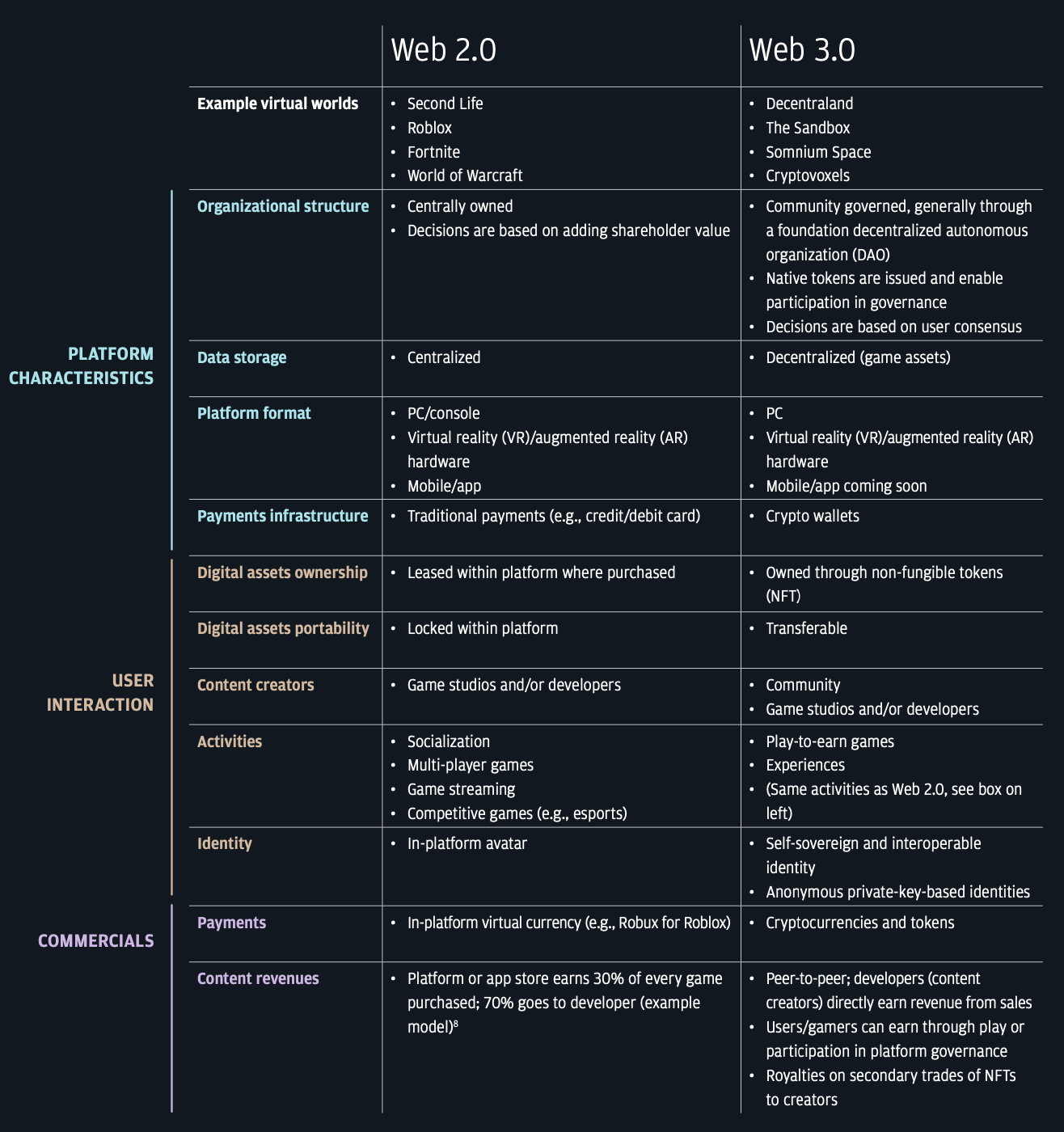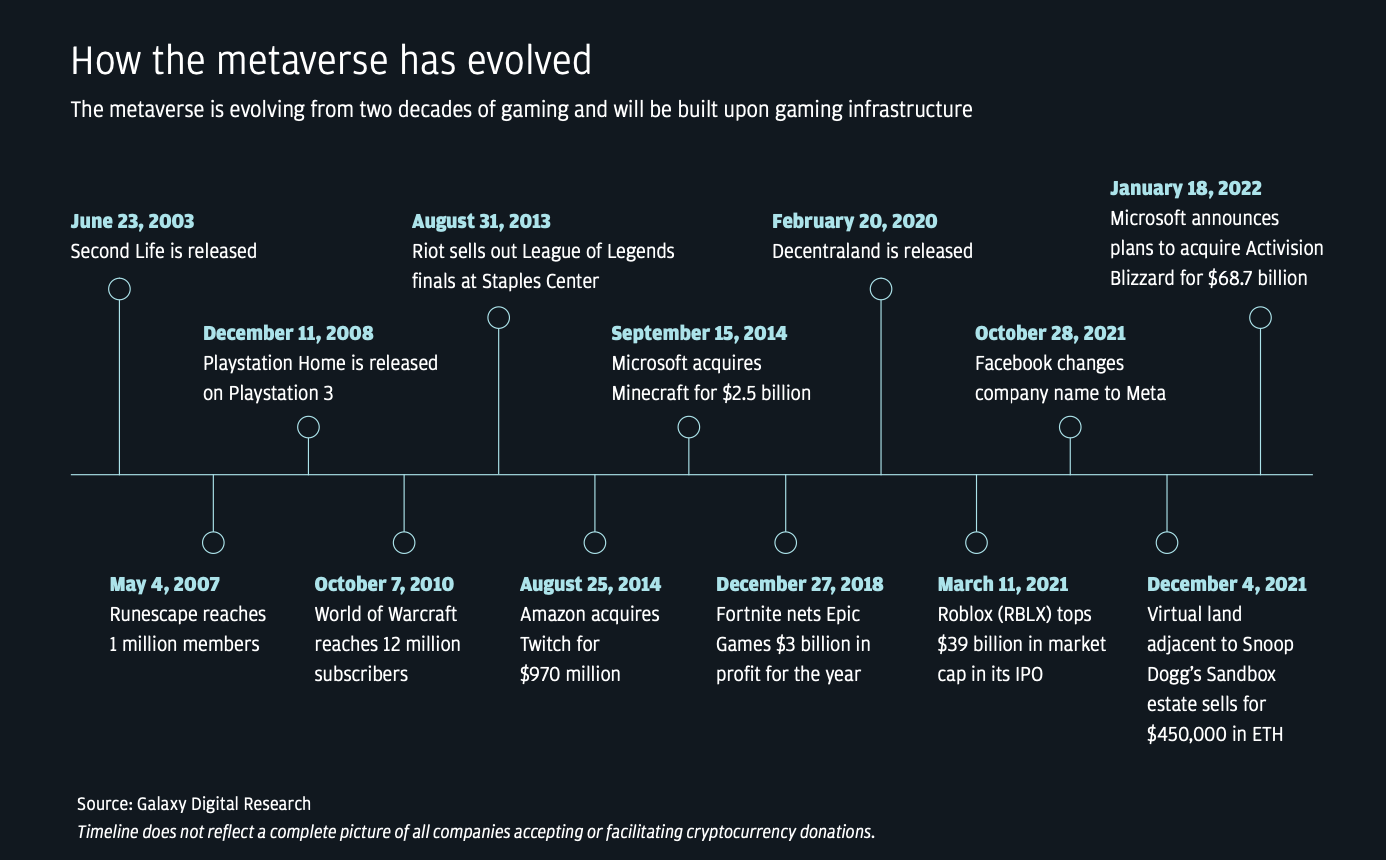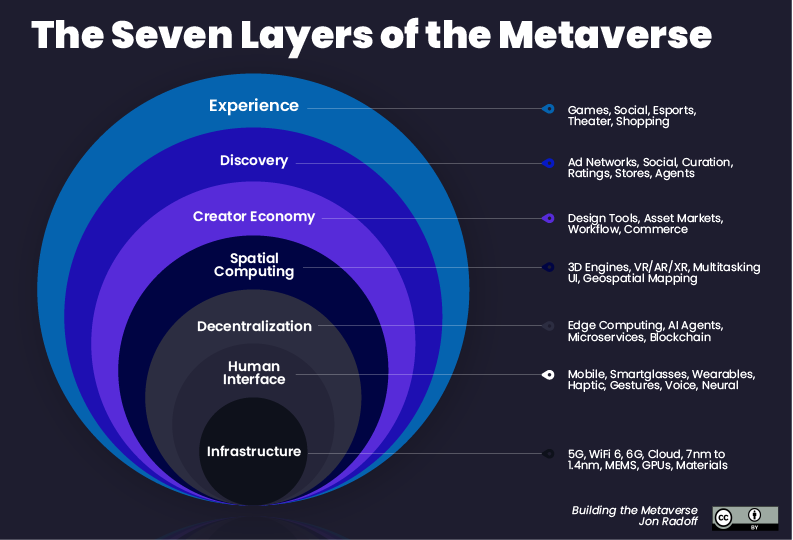Beyond all the hype, the “metaverse” reaches an inflection point, and a $3 trillion opportunity for business over the next decade.
May 17, 2022

New: Value Creation in the Metaverse, by McKinsey.
$54 billion per year is currently spent on virtual goods, almost double the amount spent buying music, says a new report, that goes beyond the hype to explore the real business potential of what we interchangeably term Web3 and the metaverse. Another report, by Meta Platforms, suggests that overall, the metaverse could be a $3 trillion opportunity for business by 2031.
JP Morgan’s new report on “Opportunities in the Metaverse: How businesses can explore the metaverse and navigate the hype vs. reality” argues that “the elements of a new digital age are converging at scale” and that “the metaverse is the driving force bringing these elements together in a unified, immersive experience.”
First some definitions, as amidst all the jargon and hype, it’s not easy to understand what we are actually talking about.
“In the simplest terms, the metaverse is the internet, but in 3D,” says Deloitte. “It’s a form of digital interaction where connected, virtual experiences can either simulate the real world or imagine worlds beyond it. Many of the metaverse ingredients are with us now – think interacting with lots of people and content made by them, in persistent, immersive worlds across many devices, including virtual reality. The more these components intertwine, the closer we get to a fuller version of the metaverse.”
“Many of the metaverse ingredients are with us now – think interacting with lots of people and content made by them, in persistent, immersive worlds across many devices, including virtual reality. The more these components intertwine, the closer we get to a fuller version of the metaverse
JP Morgan’s definition goes further: “The metaverse is a seamless convergence of our physical and digital lives, creating a unified, virtual community where we can work, play, relax, transact and socialize. The metaverse is still early in its evolution, and there is no singular, all-encompassing definition to which people can turn. Themes of what the metaverse is and could be, however, are emerging. A key point is that there is no one virtual world but many worlds, which are taking shape to enable people to deepen and extend social interactions digitally. This is done by adding an immersive, three-dimensional layer to the web, creating more authentic and natural experiences. The metaverse even has the promise of facilitating accessibility from the comfort of the home, breaking down boundaries and democratizing access to key goods, services and experiences.
Before diving deeper into the metaverse, it’s important to lay the foundation between features of today’s metaverse—Web 2.0 characteristics, and the emerging Web 3.0 characteristics. While the JP Morgan table below highlights our assessment of the key metaverse features between the two, the lines are blurring as more and more traditional virtual worlds are adopting elements of the blockchain-based worlds.”

Some interesting anecdotal stats from JP Morgan include
- Every year, $54 billion is spent on virtual goods, almost double the amount spent buying music
- Approximately 60 billion messages are sent daily on Roblox
- GDP for Second Life was about $650M in 2021 with nearly $80M USD paid to creators
- Non-fungible tokens (NFTs) currently have a market cap of $41 billion
- Price of a parcel of virtual land doubled in 2021, from $6k in June to $12k by December
- In-game ad spending is set to reach $18.41 billion by 2027
The concept of a metaverse is not a new one. “In many ways this is a linear progression. Online, multi-player, role-playing worlds like The Sims or Second Life have been around for nearly 20 years, with players spending an average of 20 hours per week in these worlds.9 Modern equivalents like Minecraft, World of Warcraft and Fortnite have hundreds of millions of users, and huge supporting economies.”
Here is a useful timeline from JP Morgan’s report, showing development over the last 20 years (it seems a long time since I was designing my avatar to live in Second Life!):

We are now at an inflection point, where “metaverse” talk seems to have reached peak hype. This is fuelled by tech companies and media, but also due to a convergence of emerging trends.
A number of new technologies have come together to enable this vision of the metaverse. Augmented reality (AR) and virtual reality (VR) headsets have become cheaper and more powerful, improving the user experience. Blockchain has enabled digital currencies and NFTs. The new methods to transact and own digital goods are allowing creators to monetize their activities through tokens. In addition to monetization, and as a means to exchange value, token-holders can also participate in the platform’s governance (e.g. vote on decisions). This democratic ownership economy coupled with the possibility of interoperability, could unlock immense economic opportunities, whereby digital goods and services are no longer captive to a singular gaming platform or brand.
Credit Suisse, in a new report “Metaverse: A Guide to the Next-Gen Internet” says “the metaverse is best understood as an evolution of the internet into a more spatially immersive, compelling, and frictionless 3D web, viewable by virtual reality (VR) and augmented reality (AR), along with traditional compute devices, with three key aspects: presence, interoperability and standardisation. There are five key vectors for metaverse advancements, in our view: (1) hardware; (2) infrastructure; (3) content; (4) community; and (5) currency/settlement mechanism.

Jon Radoff, CEO of Beamable, a Live Game Services platform, is a prominent industry commentator on the topic of the metaverse. His prior work has focussed on online communities, internet media and computer games. He sees the metaverse as composed of seven layers:
- Experience: The experience layer is where users do things in the metaverse including gaming, socialising, shopping, watching a concert or collaborating with co-workers. The metaverse experiences do not need to be 3D or 2D, or even necessarily graphical; it is about the inexorable dematerialisation of physical space, distance and objects. When physical space is dematerialised, formerly scarce experiences may become abundant.
- Discovery: The discovery layer is about the push and pull that introduces people to new experiences. Broadly speaking, most discovery systems can be classified as either inbound (the person is actively seeking information about an experience) or outbound (marketing that was not specifically requested by the person, even if they opted in). The discovery layer could include the curated portals, online agents, rating systems and advertising networks drawing users to discover different areas.
- Creator economy: Not only are the experiences of the metaverse becoming increasingly immersive, social, and real-time, but the number of creators who craft them is increasing exponentially. This layer contains all of the technology that creators use daily to craft the experiences that people enjoy.
- Spatial computing: Spatial computing has exploded into a large category of technology that enables us to enter into and manipulate 3D spaces, and to augment the real world with more information and experience. The key aspects of such software includes: 3D engines to display geometry and animation; geospatial mapping; voice and gesture recognition; data integration from devices and biometrics from people; and next- generation user interfaces.
- Decentralisation: The ideal structure of the metaverse is full decentralisation. Experimentation and growth increase dramatically when options are maximised, and systems are interoperable and built within competitive markets. Distributed computing powered by cloud servers and microservices provide a scalable ecosystem for developers to tap into online capabilities without needing to focus on building or integrating back-end capabilities. Blockchain technology, which enables value- exchange between software, self-sovereign identity and new ways of unbundling and bundling content and currencies, is a large part of decentralisation (this area of innovation can be called Web 3.0).
- Human interface: Computer devices are moving closer to our bodies, transforming us into cyborgs. Smartphones have evolved significantly from their early days and are now highly portable, always- connected powerful “computers”. With further miniaturisation, the right sensors, embedded AI technology and low-latency access to powerful edge computing systems, they will absorb more and more applications and experiences from the metaverse. Dedicated AR/VR hardware is also coming into the market, and in the coming years will likely evolve significantly. Beyond smartglasses, there is a growing industry experimenting with new ways to bring us closer to our machines such as 3D-printed wearables integrated into fashion and clothing.
- Infrastructure: The infrastructure layer includes the technology that enables our devices, connects them to the network and delivers content. This includes the semiconductors, battery technology, cloud servers and storage, and 5G and Wi-Fi transmission required. The infrastructure upgrades on compute, connectivity and storage supplemented by AI should dramatically improve bandwidth while reducing network contention and latency, with a path to 6G in order to increase speeds by yet another order of magnitude.
Meta Platforms, having staked its future on evolving its fading Facebook social media platform into the driving hear of a future “metaverse” by 2030, has just published a new report with Analysis Group titled “The Potential Global Economic of the Metaverse”, that also seeks to quantify the economic opportunities in Web3, suggesting an estimated a “gross metaverse domestic product” of $3 trillion in 2031.
“One way to think about the metaverse is as a set of interconnected digital spaces, including immersive XR experiences that combine the digital and physical worlds, in which individuals can easily move between different spaces and experiences as well as interact and collaborate with other people who are not in the same physical space,” the Meta-sponsored research says. “Some of the early components of the metaverse and the experiences and activities it is envisioned to support or enable are already in exhibit, such as augmented reality, virtual reality, mixed reality, blockchain, and non-fungible tokens.”
Since reinventing itself as Meta, Zuckerberg’s company lost $3 billion in Reality Labs, in the first quarter of 2022. Reality Labs is its division that experiments with virtual and mixed reality and other tech. The report cautions that the path to the metaverse will not be smooth. It also compared the metaverse to the rise of mobile devices saying “While it is possible that, like many other previously ‘hyped’ technological innovations, the metaverse never comes to fruition as currently envisioned, the goal of our analysis is not to predict whether the metaverse will be successful,” but “to focus on measuring the potential economic impact of the metaverse if it were to evolve like prior successful technologies.”
Find out more
- Metaverse Myths and Magic: New Keynote by Peter Fisk
- Winning with the Megatrends, Markets and Metaverses: Keynote by Peter Fisk
- Business Recoded: Have you the Courage to Create a Better Future? by Peter Fisk
- The Future MBA. Everything you need to Lead the Future: 3-day workshop by Peter Fisk
- Purpose, Vision and Strategic Roadmap: Facilitated consulting led by Peter Fisk
Contact peterfisk@peterfisk.com
More from the blog